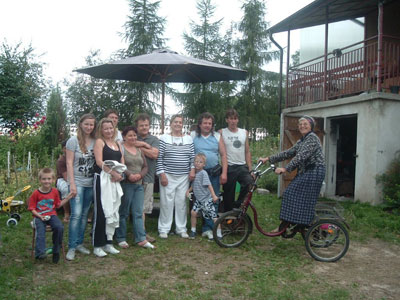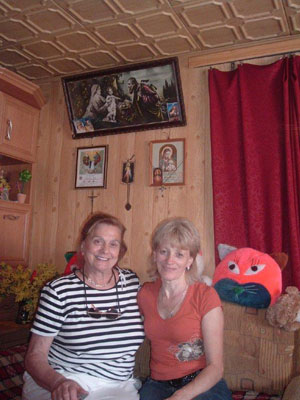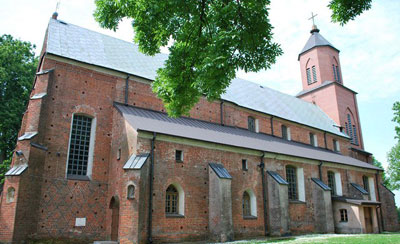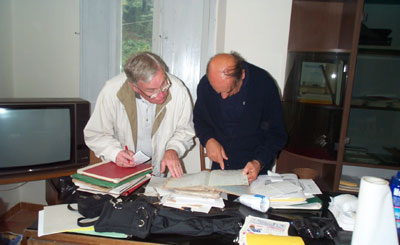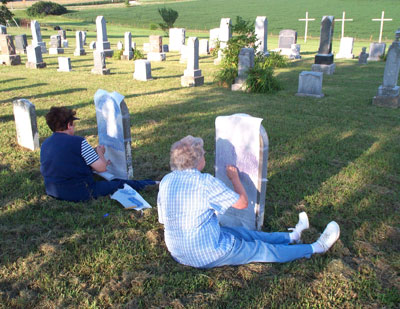Looking for foreign relatives or ancestors
This item appears on page 40 of the January 2013 issue.
ITN asked subscribers who had attempted to trace a branch of their ancestry or find lost or unknown relatives outside of the US to each let us know the types of resources they used. We wanted to know which websites proved helpful; whether or not they looked for records of baptisms, marriages or land ownership in a church, courthouse or library; where and approximately when they conducted their in-person search; whether or not they visited a graveyard and any advice they had on doing that; what sort of expenses were involved in all this, and, upon discovering any relatives, how they contacted them and how they were received.
We printed a few responses in last month’s issue. Here are a couple more, with more to come.
What an exciting and stimulating experience I had when I went to Poland in 2011 to see where my grandparents grew up.
I had been told that my father was born in Poland in 1910 and came to the US as an infant with his mother. First, I went through papers that I had after my father’s death and found his Polish birth certificate. A friend translated it for me. It mentioned the city of Andrzejewie, which is about 60 miles northeast of Warsaw.
I joined Ancestry.com, which provided me with access to the US Census records, death/marriage certificates, military service records and ship manifests. The 1920 and 1930 census records were very helpful, identifying family members and their ages. These records also showed the year anyone had immigrated and whether he or she could read or write. The ship manifests listed each passenger’s home village, final destination and occupation and who was going to meet him or her at their port of arrival.
My grandparents had immigrated to the villages around Rutland, Vermont, to work in the marble industry. I knew I’d have to go to that area to do further research at town halls and Polish churches and cemeteries and review newspaper archives. The trip to Vermont was a major success, as the baptismal records at the St. Stanislaus Church in West Rutland went back to the early 1900s. They spelled out children’s and parents’ names and named the villages where my grandparents had lived in Poland.
I visited the cemeteries and took pictures of every headstone. These, of course, showed the years the people were born and died, which helped in researching Vermont death certificates and newspaper obituaries. The death certificates provided not only exact birth and death dates but causes of death. The obituaries provided information on surviving relatives.
It amazed me the amount of information that was in many of these documents. One of the surprising records that I found was the 1915 Rutland Herald newspaper account of my father’s brother, who had drowned playing by a river near the family home in Rutland when he was only three years old.
I was now ready to plan to travel to Poland to visit my grandparents’ villages. I didn’t know if there were any relatives living in the area, and I do NOT speak Polish. I needed to find an interpreter and driver.
Among ITN’s advertisers I found guides Ziggy Pelczyk and his wife, Joanna (zpelczyk@wp.pl). Through e-mails, we worked out what I wanted to accomplish and agreed on a daily all-inclusive price. We paid them $200 a day to cover their expenses of the car, hotel and food. (I stayed at a hotel near Andrzejewie for two nights for only $25 per person per night.)
Ziggy and Joanna met me at the Warsaw airport. I could not have had better guides; they spoke English fluently and had tremendous knowledge about Poland’s history. We spent a couple days visiting the beautiful city of Warsaw before driving the 60 miles to Andrzejewie.
Ziggy had made an appointment with the clerk at Andrzejewie’s City Hall to review the city records, which went back only 100 years. The clerk found the death certificate of my grandfather’s brother and my grandmother’s brother. We now knew where the families had once lived.
The clerk’s husband was the mailman in the area, so she called him and asked whether he knew of any living relatives in the area. He said that there were living relatives of both of my grandparents and gave us their names and addresses.
The village names were Nowa Ruskoleka and Stara Ruskoleka. Ziggy drove up to the small, wooden farmhouses in each village, and people came out to talk with us. They were so happy that someone from the US had researched their family’s roots.
We exchanged stories. Ours, about families who had immigrated to the US, were of success and happiness. Theirs, about family members who had stayed in Poland, described how they survived the fighting in their backyards between Germans and Russians in September 1939 and the brutal treatment of civilians in the years that followed. (The old men would talk about the brutality that happened, but the women did not want to discuss any part of the atrocities, as many had been raped.)
One relative who lived in Andrzejewie, Stasia, 68 years old, had been studying the family history and was a great help. She took us to the church in town where my father had been baptized and my grandparents were married; to the church cemetery where my great-uncle was buried; to Nowa Ruskoleka, where the Sobotka family’s wooden house once stood, and to meet another relative.
She then took us to Stara Ruskoleka, where my grandmother was born. There I met Halina, 85, who had married the son of one of my grandmother’s brothers. My grandmother had only two brothers and both had immigrated to the USA. I learned that it was customary for girls who married to each live with their husband’s family, so when my grandmother’s sisters married, they left their parents’ home and the brothers had to return to Poland to run the farm and take care of their parents. Halina provided me with pictures of the brothers.
I had scheduled only three days in Andrzejewie because I never dreamed that I would locate any family members. It was exhilarating to discover living descendants who were as interested as I was about finding family members.
I continue to e-mail Stasia and, through Ancestry.com, have helped her find out what happened to two great-uncles who had immigrated to the USA, even locating their great-grandchildren for her. (One of the great-uncles had changed his name from Milowicki to Mills, but I discovered him through the death certificate.)
It does take time to find information about your ancestors and do the follow-up, but it is well worth the effort. Even if you have very little data, you will be amazed at what you learn.
Mary Anne (Sobotka/Bonczyk) Christie, Cincinnati, OH
Our interest in genealogy began when my husband’s father died in 1957 and the family suggested that he begin doing research into the family name — how the name was changed, whence the family emigrated, etc. On butcher paper, a family genealogy chart was drawn with all the memories everyone could recollect. Eighty-five percent of it turned out to be wrong (!), but it did give us a starting place… and an obsessive hobby was born.
After more than 45 years, my husband, Bob, and I have traced our ancestry back to the 1700s and have written five books — a legacy of our heritage to hand down to our children and grandchildren. Not just lists of names, our books include the personal and timeline histories of each ancestor — who they were; how they lived during war, depression or famine; why and how they immigrated to the United States; what they found, and how they survived.
Bob started his genealogy research by taking an adult education class. As his interest grew, he joined Ancestry.com and visited the Mormon Library in Salt Lake City, the National Archives (with a stack-reader access permit, which can no longer be obtained), the Library of Congress (access permit now unavailable) and Ellis Island.
Together, we looked through numerous city, state and church archives and visited many cemeteries. Extremely helpful were the local LDS FamilySearch Centers. (Editor’s note: With records of people of many faiths, these centers are found in cities and towns worldwide and are units of the Family History Library run by The Church of Jesus Christ of Latter-day Saints, aka the Mormon church. For a list of the 4,500 FamilySearch Centers in 88 countries, visit https://familysearch.org/locations. [Note incorrect website printed Dec. ’12, pg. 42.])
National Geographic magazines were a vital resource for history and maps. We also attended family reunions and spoke to people with long memories.
We researched what changed in the history of each locale of our ancestors, what caused the change, where any records (national, church or baronial archives) may have been moved and what we needed to do to have access. Trivial facts became important, as did conjecture at times. Every area was different. The only common denominator was war (Napoleonic and others); over such historic times, records were safeguarded and/or moved.
There are a few places about which we did specific research on our families using professional archivists/researchers: Schwerin, Germany (1996-2004); Pilzen, Czech Republic (2000-2006), and Pescia and Prato, Italy (2006-2010).
• After attending a family reunion in Nebraska, a cousin mentioned that the family had come from the Mecklenburg region of GERMANY and had embarked to the US from Hamburg. She also gave us an 1837 baptismal letter from a church in Neukirchen.
Bob wrote to the Hamburg Immigration Center (no longer in existence) and inquired about shipping manifests and also about any researchers who could speak and write in English. A researcher was recommended, one who has become our very good friend.
Bob also joined the Immigrant Genealogical Society in Burbank, California (phone 818/848-3122), whose specialties are Mecklenburg and Pomerania.
On our first trip to Schwerin (1999), without a guide, we were lucky to find the family village of Neukirchen, including the cemetery and church. The pastor was very enthused about our interest in the place where Bob’s great-grandmother was born and baptized. He gave us a tour of the property, including a look at ancient records. (For his help, we made a donation of €100 toward the restoration of the church.)
In the 1800s, barons of a manor refused permission for their workers (previously serfs) to marry because, if they allowed it, they would be financially responsible for their housing and food. As a result, there was a large population of families with parents who could not marry and with nowhere to live. In great-grandmother’s case, the family with five girls had no choice but to emigrate. They left for America in 1856.
Around Neukirchen, church records before 1872 were located in Schwerin church archives and were written in the “old” German script. Only a few individuals, besides scholars and researchers, can read this script. This is where an archivist comes in handy.
Our researcher friend became our personal guide during our second trip to Schwerin and Neukirchen (2002). Because he was a certified archivist, we had access to the original books and manuscripts. With him, we could actually touch and feel the documents and take digital nonflash photographs. The cost for this initial research was approximately €200.
• Our researcher in Schwerin had a 1910 German map of the Bohemian area of the CZECH REPUBLIC. This gave us our first clue about what to ask for in finding an archivist for researching our ancestors there.
We found our Czech researcher on the Internet and gave him the information we had: Bob’s grandfather’s recollection of a mill and granary that his father owned in Nýrsko (Neuern)/Klatovy (Klattau) before coming to the US in 1882. This researcher had access to the national archives in Prague.
When asked where they are from, most immigrants name the largest city nearby to the village where they actually lived, but that is not necessarily where their families’ documents, records, churches or cemeteries are located. Together with our researcher, we had great success in finding records in both Pilzen and the smaller towns. We paid the researcher €200 for his documentation and photographs of the village and mill. These he sent to us via e-mail.
On a trip to the Czech Republic in 2005 with our granddaughter, we wanted to visit the old homestead near Klatovy. We asked the owner of the pension where we were staying if she could find someone to help us with the language. An enthusiastic 39-year-old, Standa, arrived on his bicycle, and we drove to the village of Depoltice (Depoldowitz), where the mill and granary were located. Standa found the caretaker of the church, who unlocked the doors.
We then went to the homestead and met the owners. What a surprise and shock to them! “No, this was not your property!” they told us. They thought we wanted to take the property back! Once that was straightened out, with great relief they invited us to stay for lunch.
Bob always travels with a brochure of our records. He explained that our family once owned the property and showed them the 1837 records and 1882 photographs of his grandfather. We had a grand time finding out the history and local situation after the Czech Republic came into being.
Standa then took us to the archives in Pilzen, but we were told we had to make an appointment two weeks hence to see the microfilm. When our translator exclaimed that we were travelers there for only one day, the doors flew open! The archive staff set up a special table and brought out the original books, allowing me to take digital nonflash pictures. We paid Standa €200 plus beer and meals.
• I still have family in ITALY, and they have not moved far from the original home in northern Tuscany. I wanted to find records about my father’s family from the period before my grandparents immigrated to America in 1892 and about my mother’s family before she immigrated in 1931.
In 2008, Bob and I researched my father’s family in both the civil and church archives of Lucca and Pescia. When we visited the civil archives for the diocese of Lucca, we were allowed to hold 800-year-old scrolls (not related to our search but fascinating)!
Initially, we were stalled because the records were not in the churches. As it happened, we became good friends with a history professor at the University of Pisa who had collected and preserved church documents throughout the diocese of Pescia.
We visited the archives, but the professor had no luck investigating a specific date of baptism at a specific church. Finally, we found my grandfather under his first name of Giovanni rather than his second name by which we knew him.
We learned that in both Germany and Italy, children often each have, for example, Marie/Maria or Johann/Giovanni as a first name but that they are then called by their second name, which is the name most people are looking for in records. It is very important to understand the familial names because the birth names become lost over time.
For the professor’s services, we donated €200 to the archives.
The professor recommended a colleague to help us with my mother’s genealogy in Prato. In 2009 he performed much of his research by letter to churches and archives, some successful, some not. He prepared all the paperwork and documents and presented them to us at our B&B villa in Prato. We paid him €500.
Since we like to “see for ourselves,” we followed up by viewing and photographing the documents personally, visiting the churches and talking to the pastors on items of interest, especially about the small church where my grandmother was baptized in Provincia di Prato.
Do you realize that the LDS Church goes to the ends of the world to try to microfilm every church and civic record? Who knew that the records of a tiny Italian hill town could be found in a FamilySearch Center in the US?!
I should note, though, that the Catholic Church has refused to allow the Mormons to microfilm their records. The FamilySearch Center does have the civil records for military personnel, including any relocations, plus census and estate records, but it has no Catholic Church records, including cemetery records.
Archivists and researchers are invaluable, but mostly they present you with copies of documents or with a form with the vital information but nothing else. That may be sufficient, but Bob and I like to see the original documents, touch them (with cotton gloves), photograph them (digital nonflash), read all the “side notes” (many very important, such as someone’s being born on a train and baptized in the nearest town), see the churches where ancestors worshiped, meet the pastor or minister, hear the stories and immerse ourselves in the history.
Here are important things to keep in mind when doing research:
•LISTEN, both phonetically and literally. It is important to understand a name or a word. Have someone write it down and have them speak slowly and clearly.
• Keep good notes “ORGANIZED” because you will come back to them repeatedly over 30 years or more.
• DO NOT GUESS! Don’t publish your information until you are positive it is correct. Check and double-check and cross-reference all your data. We like to verify with two or more separate sources.
Recollections only serve you in starting your research. You want to be accurate as well as successful. It may take you a while, but that is a big part of unraveling the mystery. Your children and grandchildren deserve no less.
Research is a never-ending process but a lively and enjoyable one, except when you’ve been looking at microfiche for five hours straight, but that is part of the process. The payoff is an occasional ‘A-ha!’ or ‘There he is!’ moment.
In our researching adventures, our experiences included fascinating people and events. Our memories are vast, and some took our breath away.
In Wisconsin, Nebraska and California, the states to which our ancestors immigrated, we visited towns, cemeteries, churches and archives.
In Germany we held an 11th-century chalice, saw the baptismal fonts where our ancestors were baptized and churches where they were married, played a 17th-century organ and met an evangelical Lutheran confirmation class of 12-year-olds.
In the Czech Republic we met the present-day owners of our family’s 18th-century homestead, gathered many family stories and met and ate with villagers.
In Italy we stayed at the site where my grandparents lived and worked in the late 1800s, a former paper factory now renovated into a 3-star hotel.
If anyone would like the e-mail addresses of the researchers we used, contact me via e-mail c/o ITN.
Carol Ann Nulk
San Jose, CA

